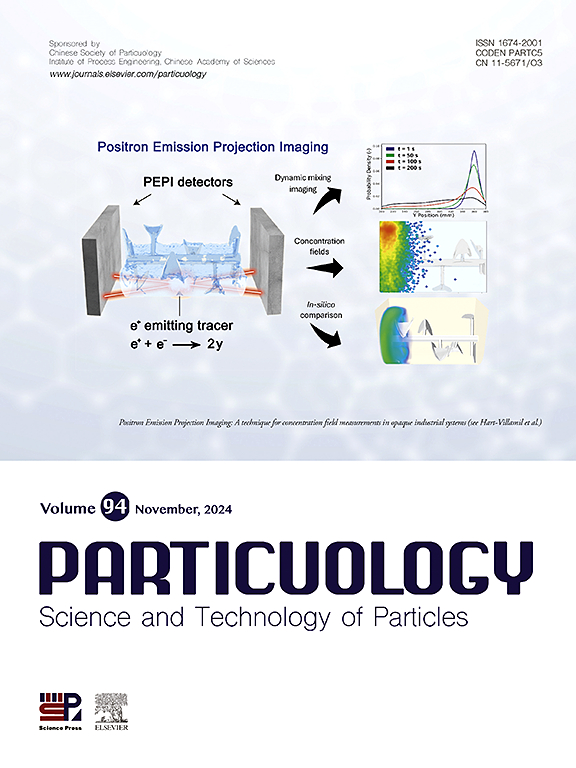ChCl - PTSA深共晶溶剂对锂离子电池阳极/阴极集体溶解的实验和DFT模拟
IF 4.3
2区 材料科学
Q2 ENGINEERING, CHEMICAL
引用次数: 0
摘要
在这项研究中,阳极和阴极的累积解散(A / C)的混合锂离子电池(LIBs)深度氯化胆碱组成的低共熔溶剂(DES) (ChCl)和p-toluenesulfonic酸(PTSA)评估40 - 100°C的温度范围内,时间范围为20 - 1440分钟。结果表明,镍,有限公司,锰、和铜金属溶解效率超过90%在100°C和1440分钟,而Al溶解在相同的条件下只有26%。XRD和SEM-EDS分析证实了这些发现,检测到微量残留的Ni, Co, Li, Mn或Cu化合物。FTIR证实了ChCl−PTSA DES地层及其浸出后的稳定性,可以在最小变化的情况下重复使用,实现可持续的金属回收。ChCl-PTSA DES具有对称的σ−分布(以σ = 0±0.2 e/Å2为中心)、cosmos鉴定的亲核/亲电区(+0.214 ~−0.158 e/Å2)和Mulliken电荷(O:−0.47 ~−0.65,Cl:−0.39,H: +0.06 ~ 0.15)。这些密度泛函理论(DFT)模拟强调电荷互补性,通过磺酸氧、氯化物和铵基相互作用稳定共晶结构。对纯金属离子DES和含金属离子DES的DFT模拟表明,ChCl−PTSA的HOMO−LUMO间隙为3.87 eV,能够实现高效的金属浸出。Co(II) (2.29 eV)和Mn(II) (0.56 eV)比高氧化态表现出更高的稳定性,而Li(I)扩大了间隙(3.97 eV),增强了稳定性。DFT模拟揭示了ChCl-PTSA中金属离子明显的COSMO表面电荷分布:(1)高极化(Co(II): +0.3253 ~−0.2158 e/Å2;Mn(II): +0.3769 ~−0.2496 e/Å2),具有较强的电荷分离性和较高的反应活性;(2)中极化(Ni(II): +0.2240 ~−0.2061 e/Å2;Al(III): +0.2547 ~−0.2192 e/Å2),平衡反应性和稳定性;最小摄动(Li(I): +0.2485 ~−0.1861 e/Å2;Cu(I): +0.3233 ~−0.1876 e/Å2),表现出稳定的电荷离域。本文章由计算机程序翻译,如有差异,请以英文原文为准。

Experimental and DFT simulation of collective dissolution of anode/cathode of Li−ion batteries using a ChCl−PTSA deep eutectic solvent
In this study, the cumulative dissolution of the anode and cathode (A/C) mixture of Li-ion batteries (LIBs) in a deep eutectic solvent (DES) composed of choline chloride (ChCl) and p-toluenesulfonic acid (PTSA) was evaluated within a temperature range of 40–100 °C and a time range of 20–1440 min. The results showed that Ni, Co, Li, Mn, and Cu metals dissolved with over 90 % efficiency at 100 °C and 1440 min, while Al dissolved at only about 26 % under the same conditions. XRD and SEM-EDS analyses confirmed these findings, with minimum residual compounds of Ni, Co, Li, Mn, or Cu detected. FTIR confirmed ChCl−PTSA DES formation and its after-leaching stability, allowing reuse with minimal changes for sustainable metal recovery. The ChCl–PTSA DES exhibits a symmetric σ−profile (centered at σ = 0 ± 0.2 e/Å2), COSMO-identified nucleophilic/electrophilic regions (+0.214 to −0.158 e/Å2), and Mulliken charges (O: −0.47 to −0.65, Cl: −0.39, H: +0.06 to 0.15). These density functional theory (DFT) simulations highlight charge complementarity, stabilizing the eutectic structure via sulfonic oxygen, chloride, and ammonium group interactions. According to DFT simulation for pure and containing metal ions DES, the ChCl−PTSA exhibits a 3.87 eV HOMO−LUMO gap, enabling efficient metal leaching. Co(II) (2.29 eV gap) and Mn(II) (0.56 eV) show higher stability than higher oxidation states, while Li(I) widens the gap (3.97 eV), enhancing stability. DFT simulations reveal distinct COSMO surface charge distributions for metal ions in ChCl–PTSA, categorized as: (1) highly polarized (Co(II): +0.3253 to −0.2158 e/Å2; Mn(II): +0.3769 to −0.2496 e/Å2), exhibiting strong charge separation and high reactivity; (2) moderately polarized (Ni(II): +0.2240 to −0.2061 e/Å2; Al(III): +0.2547 to −0.2192 e/Å2), balancing reactivity and stability; and (3) minimally perturbed (Li(I): +0.2485 to −0.1861 e/Å2; Cu(I): +0.3233 to −0.1876 e/Å2), showing stable charge delocalization.
求助全文
通过发布文献求助,成功后即可免费获取论文全文。
去求助
来源期刊

Particuology
工程技术-材料科学:综合
CiteScore
6.70
自引率
2.90%
发文量
1730
审稿时长
32 days
期刊介绍:
The word ‘particuology’ was coined to parallel the discipline for the science and technology of particles.
Particuology is an interdisciplinary journal that publishes frontier research articles and critical reviews on the discovery, formulation and engineering of particulate materials, processes and systems. It especially welcomes contributions utilising advanced theoretical, modelling and measurement methods to enable the discovery and creation of new particulate materials, and the manufacturing of functional particulate-based products, such as sensors.
Papers are handled by Thematic Editors who oversee contributions from specific subject fields. These fields are classified into: Particle Synthesis and Modification; Particle Characterization and Measurement; Granular Systems and Bulk Solids Technology; Fluidization and Particle-Fluid Systems; Aerosols; and Applications of Particle Technology.
Key topics concerning the creation and processing of particulates include:
-Modelling and simulation of particle formation, collective behaviour of particles and systems for particle production over a broad spectrum of length scales
-Mining of experimental data for particle synthesis and surface properties to facilitate the creation of new materials and processes
-Particle design and preparation including controlled response and sensing functionalities in formation, delivery systems and biological systems, etc.
-Experimental and computational methods for visualization and analysis of particulate system.
These topics are broadly relevant to the production of materials, pharmaceuticals and food, and to the conversion of energy resources to fuels and protection of the environment.
 求助内容:
求助内容: 应助结果提醒方式:
应助结果提醒方式:


